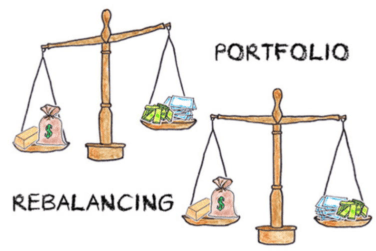- Learn
- Portfolio Rebalancing: Maintaining the Balance Between Risk and Return
Portfolio Rebalancing: Maintaining the Balance Between Risk and Return
Investment portfolio management requires constant attention and a conscious approach. Even the most perfectly constructed portfolio loses its effectiveness over time due to constant market fluctuations and changing asset values. To maintain the optimal balance between risk and return, investors need to regularly perform a procedure called rebalancing.
Table of contents
What Is Portfolio Rebalancing and Why Is It Essential?

Portfolio rebalancing is the systematic process of realigning the weightings of assets in an investment portfolio to maintain the original target allocation. This fundamental investment strategy ensures that your portfolio continues to reflect your risk tolerance, investment objectives, and time horizon despite market movements that naturally alter asset proportions.
When markets move, some investments will outperform others, causing your carefully planned asset allocation to drift from its intended targets. Without intervention, a portfolio initially allocated as 60% stocks and 40% bonds might shift to 75% stocks and 25% bonds during a bull market, significantly increasing risk exposure beyond your comfort level.
The Core Purpose of Rebalancing
The primary goal of rebalancing extends beyond simple maintenance. It serves as a disciplined approach to "buy low, sell high" by systematically reducing positions in assets that have appreciated and increasing holdings in assets that have underperformed. This counter-intuitive strategy helps investors avoid the emotional pitfalls that often lead to poor investment decisions.
Understanding When Your Portfolio Needs Rebalancing
Recognizing the right time to rebalance requires understanding various market and personal factors that can disrupt your portfolio's intended structure. Several key indicators signal when intervention becomes necessary.
Market-Driven Structural Changes
Market volatility naturally causes asset values to fluctuate, leading some investments to grow faster than others. Over time, these differences compound, creating significant deviations from your target allocation. A technology-heavy portfolio during a tech boom, for instance, might become dangerously concentrated in a single sector.
Life Cycle and Financial Situation Changes
Personal circumstances evolve continuously, affecting both risk tolerance and investment objectives. Career transitions, family changes, approaching retirement, or shifts in income all warrant portfolio adjustments. Young professionals typically maintain higher risk tolerance for potential growth, while those nearing retirement prioritize capital preservation and steady income.
Predetermined Timeline Approach
Many financial experts recommend establishing regular review periods, typically annually or semi-annually, regardless of market conditions. This systematic approach prevents emotional decision-making while ensuring consistent portfolio maintenance. Calendar-based rebalancing creates discipline and removes the guesswork from portfolio management.
Threshold-Based Triggers
An alternative approach involves monitoring asset allocations for significant deviations from targets, typically 5-10% variations. This method responds to substantial market movements while avoiding unnecessary transactions during minor fluctuations. Threshold-based rebalancing proves particularly effective during volatile market periods.
Primary Methods of Portfolio Rebalancing
Understanding different rebalancing techniques helps investors choose the most appropriate strategy for their specific circumstances, tax situation, and available resources.
The Sell High, Buy Low Method
This traditional approach involves selling portions of overweight assets and using proceeds to purchase underweight assets. The method automatically enforces the principle of selling expensive assets and buying cheaper ones, maintaining disciplined investment behavior.
Advantages:
Simple implementation process
Automatic enforcement of diversification principles
Clear, straightforward execution
Disadvantages:
High transaction costs and potential tax implications
Requires careful consideration of capital gains tax consequences
May trigger unwanted taxable events
New Capital Reinvestment Strategy
This method utilizes additional funds, such as new contributions, dividends, or bonuses, to restore portfolio balance without selling existing positions. New money flows toward underweight asset classes, gradually bringing allocations back to target levels.
Benefits:
Eliminates selling costs and tax implications
Allows organic portfolio growth
Reduces transaction frequency
Limitations:
Requires regular cash inflows
May take longer to achieve target allocations
Dependent on availability of new capital
Hybrid Rebalancing Approach
Combining both methods provides maximum flexibility, using new capital when available while selling overweight positions when necessary. This approach optimizes cost efficiency while maintaining portfolio discipline.
Advantages:
Cost-effective execution
Maintains optimal risk-return balance
Flexible implementation
Challenges:
More complex to implement
Requires careful tax planning
Demands active monitoring
Dividend and Coupon Reinvestment
This passive approach automatically reinvests dividend payments and bond interest into underweight asset classes, maintaining balance without active intervention. Regular income distributions naturally support rebalancing efforts.
Strengths:
Automated execution process
Enhances compound growth potential
No additional transaction costs
Limitations:
Only applicable to dividend-paying assets
Limited effectiveness without regular distributions
May not address large allocation drifts
Determining Optimal Rebalancing Frequency

The frequency of portfolio rebalancing significantly impacts both costs and effectiveness, requiring careful consideration of multiple factors including investment strategy, market conditions, and personal preferences.
Fixed Schedule Approach
Regular rebalancing on predetermined dates, such as annually or quarterly, provides predictability and systematic portfolio maintenance. This approach works well for disciplined investors who prefer structured investment management.
Annual Rebalancing: Suitable for most long-term investors, providing adequate adjustment frequency while minimizing transaction costs.
Quarterly Reviews: Appropriate for more active investors or volatile portfolios requiring closer monitoring.
Monthly Adjustments: Typically excessive for most investors, leading to unnecessary costs and over-trading.
Threshold-Based Rebalancing
Monitoring allocation drifts and rebalancing when deviations exceed predetermined limits offers responsive portfolio management while avoiding unnecessary transactions during minor market movements.
5% Threshold: Conservative approach suitable for risk-averse investors seeking tight control over allocations.
10% Threshold: Moderate approach balancing responsiveness with cost efficiency, appropriate for most investors.
15% Threshold: Aggressive approach accepting larger deviations in exchange for reduced transaction frequency.
Combined Strategy Implementation
The most effective approach often combines both methods, conducting regular annual reviews while maintaining threshold triggers for significant market events. This hybrid strategy provides both discipline and flexibility.
Factors Influencing Rebalancing Decisions
Several critical factors determine optimal rebalancing frequency and methodology, requiring careful analysis of individual circumstances and market conditions.
Investment Strategy Considerations
Aggressive growth strategies typically require more frequent rebalancing due to higher volatility and greater potential for allocation drift. Conservative income-focused portfolios generally need less frequent adjustments due to more stable asset performance.
Market Volatility Impact
High-volatility markets demand increased monitoring and potentially more frequent rebalancing to maintain risk control. During stable market periods, less frequent adjustments prove sufficient while reducing unnecessary costs.
Tax and Cost Implications
Transaction costs, including brokerage fees and bid-ask spreads, erode portfolio returns with excessive rebalancing. Tax-efficient strategies consider the timing of sales to optimize after-tax returns, particularly in taxable accounts.
Account Type Considerations
Tax-advantaged accounts like 401(k)s and IRAs allow unlimited rebalancing without tax consequences, supporting more frequent adjustments. Taxable accounts require careful consideration of capital gains implications when rebalancing.
The Psychology of Disciplined Portfolio Management
Successful portfolio rebalancing depends heavily on maintaining discipline and avoiding emotional decision-making that can derail long-term investment success.
Overcoming Emotional Investing
Market volatility triggers powerful emotional responses that often lead to poor investment decisions. Fear during market downturns causes panic selling, while greed during bull markets encourages excessive risk-taking. Disciplined rebalancing provides a systematic approach that removes emotion from investment decisions.
Following Objective Criteria
Establishing clear, measurable criteria for rebalancing decisions eliminates subjective judgment and emotional influence. Predetermined thresholds and schedules create objective triggers that guide action regardless of market sentiment or personal feelings.
Risk Management Through Discipline
Consistent portfolio monitoring and systematic rebalancing help maintain appropriate risk levels throughout changing market conditions. Without discipline, portfolios naturally drift toward higher concentrations in winning assets, inadvertently increasing risk exposure.
Long-Term Perspective Maintenance
Successful investors understand that short-term market fluctuations rarely impact long-term outcomes significantly. Maintaining focus on long-term goals while ignoring short-term noise requires discipline and systematic processes that rebalancing provides.
Common Rebalancing Mistakes to Avoid
Understanding common pitfalls helps investors implement more effective rebalancing strategies while avoiding costly errors that can damage long-term returns.
Over-Rebalancing Syndrome
Excessive rebalancing due to minor allocation drifts generates unnecessary costs and taxes without meaningful benefit. Establishing appropriate thresholds prevents over-trading while maintaining portfolio discipline.
Timing the Market
Attempting to time rebalancing based on market predictions often backfires, leading to poor entry and exit points. Systematic approaches remove timing decisions and market prediction from the equation.
Ignoring Tax Consequences
Failing to consider tax implications when rebalancing can significantly reduce after-tax returns. Tax-loss harvesting and strategic timing of transactions optimize tax efficiency.
Abandoning Strategy During Stress
Market stress tests investor discipline, often leading to strategy abandonment when it's needed most. Maintaining systematic approaches during difficult periods proves crucial for long-term success.
Technology Tools for Modern Rebalancing
Contemporary investors have access to sophisticated tools and platforms that simplify portfolio monitoring and rebalancing processes while reducing costs and improving efficiency.
Robo-Advisor Platforms
Automated investment platforms provide continuous portfolio monitoring and automatic rebalancing, eliminating the need for manual intervention while maintaining optimal allocations at low cost.
Portfolio Tracking Software
Comprehensive tracking tools monitor allocation drifts, calculate rebalancing needs, and provide alerts when action becomes necessary. These platforms offer detailed analytics and reporting capabilities.
Mobile Applications
Smartphone apps provide real-time portfolio monitoring and rebalancing alerts, enabling responsive management regardless of location. Mobile platforms democratize sophisticated portfolio management tools.
Building Your Personal Rebalancing Strategy
Developing an effective rebalancing strategy requires careful analysis of individual circumstances, goals, and preferences to create a sustainable long-term approach.
Assessing Your Risk Profile
Understanding personal risk tolerance and capacity helps determine appropriate rebalancing frequency and thresholds. Conservative investors typically prefer tighter controls, while aggressive investors may accept larger deviations.
Setting Realistic Targets
Establishing achievable allocation targets and rebalancing parameters prevents frustration and strategy abandonment. Realistic expectations improve long-term adherence to systematic approaches.
Creating Implementation Guidelines
Detailed written guidelines specify exactly when and how to rebalance, removing decision-making pressure during stressful market periods. Clear procedures ensure consistent execution.
Regular Strategy Review
Periodic strategy evaluation ensures continued relevance as circumstances change. Annual reviews of rebalancing approaches help optimize effectiveness and maintain alignment with evolving goals.
Conclusion: The Path to Investment Success
Portfolio rebalancing represents a fundamental component of successful long-term investing, providing the discipline and systematic approach necessary to maintain optimal risk-return characteristics despite constantly changing market conditions. The evidence consistently demonstrates that investors who maintain disciplined rebalancing strategies achieve better long-term outcomes than those who allow portfolios to drift with market movements.
The key to successful rebalancing lies not in perfect market timing or complex strategies, but in consistent execution of a well-designed plan that reflects individual circumstances and goals. Whether using simple annual rebalancing or sophisticated threshold-based approaches, the critical factor remains discipline in implementation.
Modern technology has democratized access to sophisticated portfolio management tools, making effective rebalancing strategies accessible to all investors regardless of portfolio size or investment knowledge. However, technology cannot replace the fundamental requirement for discipline and systematic thinking that successful investing demands.
As markets continue to evolve and present new challenges, the principles of systematic rebalancing remain constant. Investors who embrace these principles while maintaining focus on long-term objectives position themselves for investment success regardless of short-term market volatility or uncertainty.
The journey toward investment success requires patience, discipline, and systematic approaches that rebalancing provides. By understanding and implementing appropriate rebalancing strategies, investors can maintain optimal portfolio characteristics while pursuing their long-term financial objectives with greater confidence and improved outcomes.
No comments yet
Be the first to share your thoughts on this article